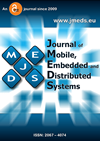Risk Assessment Model for Mobile Malware
Keywords:
Mobile Security, Malware, Risk AssessmentAbstract
The mobile technology is considered to be the fastest-developing IT security area. Only in the last year security threats around mobile devices have reached new heights in terms of both quality and quantity. The speed of this development has made possible several types of security attacks that, until recently, were only possible on computers. In terms of the most targeted mobile operating systems, Android continues to be the most vulnerable, although new ways of strengthening its security model were introduced by Google. The aim of this article is to provide a model for assessing the risk of mobile infection with malware, starting from a statistical analysis of the permissions required by each application installed into the mobile system. The software implementation of this model will use the Android operating system and in order to do so, we will start by analyzing its permission-based security architecture. Furthermore, based on statistical data regarding the most dangerous permissions, we build the risk assessment model and, to prove its efficiency, we scan some of the most popular apps and interpret the results. To this end, we offer an overview of the strengths and weaknesses of this permission-based model and we also state a short conclusion regarding model’s efficiency.
References
Kaspersky Security Bulletin, Kaspersky Lab, Global Research and Analysis Team, 2013;
Malware page on Wikipedia, http://en.wikipedia.org/wiki/Malware, accessed on May 07, 2014;
A. Gostev, Mobile Malware Evolution: An Overview, Part 1, http://www.securelist.com/en/analysis?pubid=200119916, accessed on May 07, 2014;
C.A. Castillo, Android Malware Past, Present and Future, Mobile Security Working Group, McAfee, 2011;
V. Svajcer, Sophos Mobile Security Threat Report, 2014;
V. Chebyshev, R. Unuchek, Mobile Malware Evolution: 2013 - Methods and techniques, https://www.securelist.com/en/analysis/204792326/Mobile_Malware_Evolution_2013 accessed on May 07, 2014;
A. Mylonas, A. Theoharidou, D. Gritzalis, Assessing privacy risks in Android: A user-centric approach, Dept. of Informatics, Athens University of Economics & Business;
A. Dubey, A. Misra, Android Security – Attacks and Defenses, Taylor & Francis Group, LLC, 2013;
Android Developers page – permission topic, http://developer.android.com/guide/topics/manifest/permission-element.html, accessed on May 07, 2014;
P. O. Rai, Android Application Security Essentials, Packt Publishing, 2013;
T. Boksasp, E. Utnes, Android Apps and Permissions: Security and Privacy Risks, Norwegian University of Science and Technology, 2012;
C. Y. Huang, Y. T. Tsai and C. H. Hsu, Performance Evaluation on Permission-Based Detection for Android Malware, National Taiwan Ocean University;
Microsoft Malware Protection Center, TrojanSpy:AndroidOS/Pjapps.A definition, http://www.microsoft.com/security/portal/threat/encyclopedia/entry.aspx?Name=TrojanSpy:AndroidOS/Pjapps.A#tab=1, accessed on May 07, 2014;
Android GoldDream definition provided by Symantec,
http://www.symantec.com/security_response/writeup.jsp?docid=2011-070608-4139-99, accessed on May 07, 2014
Downloads
Published
How to Cite
Issue
Section
License
Authors who publish with this journal agree to the following terms:
- Authors retain copyright and grant the journal right of first publication with the work simultaneously licensed under a Creative Commons Attribution License that allows others to share the work with an acknowledgement of the work's authorship and initial publication in this journal.
- Authors are able to enter into separate, additional contractual arrangements for the non-exclusive distribution of the journal's published version of the work (e.g., post it to an institutional repository or publish it in a book), with an acknowledgement of its initial publication in this journal.
- Authors are permitted and encouraged to post their work online (e.g., in institutional repositories or on their website) prior to and during the submission process, as it can lead to productive exchanges, as well as earlier and greater citation of published work (See The Effect of Open Access).
- The author(s) is responsible for the correctness and legality of the paper content.
- Papers that are copyrighted or published will not be taken into consideration for publication in JMEDS It is the author(s) responsibility to ensure that the paper does not cause any copyright infringements and other problems.
- It is the responsibility of the author(s) to obtain all necessary copyright release permissions for the use of any copyrighted materials in the paper prior to the submission.
- The Author(s) retains the right to reuse any portion of the paper, in future works, including books, lectures and presentations in all media, with the condition that the publication by JMEDS is properly credited and referenced.

JMEDS articles by Journal of Mobile, Embedded and Distributed Systems (JMEDS) is licensed under a Creative Commons Attribution 4.0 International License.
Based on a work at http://jmeds.eu.
Permissions beyond the scope of this license may be available at http://jmeds.eu/index.php/jmeds/about/submissions#copyrightNotice.




